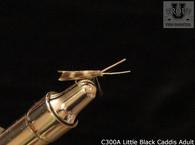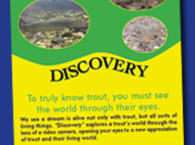In this class you will learn valuable insight into the world of the trout as seen by the trout. You will learn how your image and your movements are magnified as seen by the trout causing them spook so easily. See just how their field of vsion is impacted by refraction.
Refraction is a constant well defined phenomenon first explained by Willebrord van Roijen Snell way back in the 1600’s. It has to be understood prior to understanding how trout see images. Simply put, light entering the water from horizontal to horizontal is refracted into a cone exactly 97 degrees wide and the diameter of the window at any point in the cone is exactly 2.26 times the depth.
Put another way, Snell’s window compresses 180 degree field of vision into just 97 degrees. For example if a trout is 2 feet under water, the entire field of vision is a circle that is 2 feet X 2.26 = 4.52 feet in diameter. Therefore, at that depth, a trout can only see a fly that is within 4 ½ feet and near the perimeter of that 4 ½ ft. cone, the image will be distorted.
If you are standing on the bank 20 feet from the water’s edge, your image will be compressed into that 4.52 ft. field of vision. Obviously, you will appear very tiny to that trout. Furthermore, the image near the center of the window will be clear while the image near the perimeter of the circle will be distorted. The lower the angle of light with respect to the surface, the more it is bent when it enters the water. To net it out, at the low angle of viewing for the trout when you are on the bank, you will be very, very small and tend to be out of focus. An important consideration: As you approach the center of the cone, your image will increase in size very dramatically and your speed of movement will be magnified easily scaring the trout.
Remember that inside of that cone, the trout sees what is above the water, but outside the cone when the trout sees the underside of the surface of the water, it appears as a clear mirror. The more calm the water, the better the mirror. When a fly depresses the surface film outside of the window, the angle of the surface film changes and more light is passed through causing the trout to have a better opportunity to see the details of the fly.
Another factor resulting from refraction is that things are not always where they appear to be. For example, your rod will appear broken or closer to you than it actually is and a trout will not appear to be as deep as it actually is. Often times, we use the old timers method of “caneing” a trout. That is we will use a cane pole and suspend a dry fly from it, then dangle it over the trout in a figure eight. Often times the trout will leap to catch it several times before they actually can catch it and we set the hook.
Another consideration is the location of the trout’s eyes which are on the sides of his head. This allows the trout to see the front, the sides and most of the back as well. A blind spot of consisting of 30 degrees exists in the area directly behind the trout. Toward the rear and the side, the trout has monocular vision without depth perception. However, immediately in front and upward, the trout has depth perception or binocular vision as both eyes can focus. This is why a trout will always immediately turn to face a fly.
What are the practical applications of this phenomenon?
1. Outside the cone, the trout can not see you, but inside the cone, your size starts small but “explodes” as you get closer and the speed of your movements are magnified greatly. When inside the cone you must go painstakingly slow and when you think you are slow enough slow down by a factor of two.
2. In the cone, the trout will key not only on the movement but on color. We have already explored the trout’s ability to see color in class 406 Color Vision in Trout Eyes. You need to wear colors that blend in with the surroundings.
3. Trout have excellent vision within the center of the cone and that vision extends about 320 degrees around him except for the blind spot in back.
4. A trout can judge distance only straight ahead and immediately upward within the range of both eyes, and that is why they will face the fly directly.
5. When trout are deep, they can see a fly that is farther away, but when they are shallow, less than 2 feet, the fly needs to be within 4 ft. (depending on depth) for them to see it. When fishing dry flies and they land outside the 4 ft. diameter cone, your chances improve if the fly breaks the surface film.
Practice making extremely hardly noticeable movements when approaching the trout. Practice low and sidearm casts that where the movement can not easily be seen by the trout.
Read the book "The New Scientific Angling - Trout and Ultraviolet Vision " available from Amazon Biooks by Reed F. Curry.





